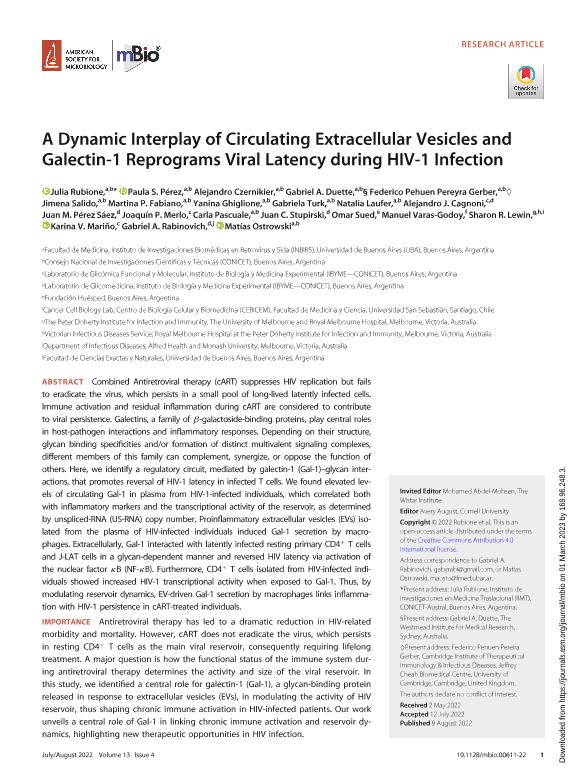Artículo
A Dynamic Interplay of Circulating Extracellular Vesicles and Galectin-1 Reprograms Viral Latency during HIV-1 Infection
Rubione, Julia ; Pérez, Paula Soledad
; Pérez, Paula Soledad ; Czernikier, Alejandro
; Czernikier, Alejandro ; Duette, Gabriel
; Duette, Gabriel ; Pereyra Gerber, Federico Pehuén
; Pereyra Gerber, Federico Pehuén ; Salido, Jimena Patricia
; Salido, Jimena Patricia ; Fabiano, Martina P.; Ghiglione, Yanina Alexandra
; Fabiano, Martina P.; Ghiglione, Yanina Alexandra ; Turk, Gabriela Julia Ana
; Turk, Gabriela Julia Ana ; Laufer, Natalia Lorna
; Laufer, Natalia Lorna ; Cagnoni, Alejandro
; Cagnoni, Alejandro ; Pérez Sáez, Juan Manuel
; Pérez Sáez, Juan Manuel ; Merlo, Joaquín Pedro
; Merlo, Joaquín Pedro ; Pascuale, Carla Antonela
; Pascuale, Carla Antonela ; Stupirski, Juan Carlos
; Stupirski, Juan Carlos ; Sued, Omar Gustavo; Varas Godoy, Manuel; Lewin, Sharon R.; Mariño, Karina Valeria
; Sued, Omar Gustavo; Varas Godoy, Manuel; Lewin, Sharon R.; Mariño, Karina Valeria ; Rabinovich, Gabriel Adrián
; Rabinovich, Gabriel Adrián ; Ostrowski, Matias
; Ostrowski, Matias
 ; Pérez, Paula Soledad
; Pérez, Paula Soledad ; Czernikier, Alejandro
; Czernikier, Alejandro ; Duette, Gabriel
; Duette, Gabriel ; Pereyra Gerber, Federico Pehuén
; Pereyra Gerber, Federico Pehuén ; Salido, Jimena Patricia
; Salido, Jimena Patricia ; Fabiano, Martina P.; Ghiglione, Yanina Alexandra
; Fabiano, Martina P.; Ghiglione, Yanina Alexandra ; Turk, Gabriela Julia Ana
; Turk, Gabriela Julia Ana ; Laufer, Natalia Lorna
; Laufer, Natalia Lorna ; Cagnoni, Alejandro
; Cagnoni, Alejandro ; Pérez Sáez, Juan Manuel
; Pérez Sáez, Juan Manuel ; Merlo, Joaquín Pedro
; Merlo, Joaquín Pedro ; Pascuale, Carla Antonela
; Pascuale, Carla Antonela ; Stupirski, Juan Carlos
; Stupirski, Juan Carlos ; Sued, Omar Gustavo; Varas Godoy, Manuel; Lewin, Sharon R.; Mariño, Karina Valeria
; Sued, Omar Gustavo; Varas Godoy, Manuel; Lewin, Sharon R.; Mariño, Karina Valeria ; Rabinovich, Gabriel Adrián
; Rabinovich, Gabriel Adrián ; Ostrowski, Matias
; Ostrowski, Matias
Fecha de publicación:
08/2022
Editorial:
American Society for Microbiology
Revista:
mBio
ISSN:
2161-2129
e-ISSN:
2150-7511
Idioma:
Inglés
Tipo de recurso:
Artículo publicado
Clasificación temática:
Resumen
Combined Antiretroviral therapy (cART) suppresses HIV replication but fails to eradicate the virus, which persists in a small pool of long-lived latently infected cells. Immune activation and residual inflammation during cART are considered to contribute to viral persistence. Galectins, a family of b-galactoside-binding proteins, play central roles in host-pathogen interactions and inflammatory responses. Depending on their structure, glycan binding specificities and/or formation of distinct multivalent signaling complexes, different members of this family can complement, synergize, or oppose the function of others. Here, we identify a regulatory circuit, mediated by galectin-1 (Gal-1)–glycan interactions, that promotes reversal of HIV-1 latency in infected T cells. We found elevated levels of circulating Gal-1 in plasma from HIV-1-infected individuals, which correlated both with inflammatory markers and the transcriptional activity of the reservoir, as determined by unspliced-RNA (US-RNA) copy number. Proinflammatory extracellular vesicles (EVs) isolated from the plasma of HIV-infected individuals induced Gal-1 secretion by macrophages. Extracellularly, Gal-1 interacted with latently infected resting primary CD41 T cells and J-LAT cells in a glycan-dependent manner and reversed HIV latency via activation of the nuclear factor kB (NF-kB). Furthermore, CD41 T cells isolated from HIV-infected individuals showed increased HIV-1 transcriptional activity when exposed to Gal-1. Thus, by modulating reservoir dynamics, EV-driven Gal-1 secretion by macrophages links inflammation with HIV-1 persistence in cART-treated individuals. IMPORTANCE Antiretroviral therapy has led to a dramatic reduction in HIV-related morbidity and mortality. However, cART does not eradicate the virus, which persists in resting CD41 T cells as the main viral reservoir, consequently requiring lifelong treatment. A major question is how the functional status of the immune system during antiretroviral therapy determines the activity and size of the viral reservoir. In this study, we identified a central role for galectin-1 (Gal-1), a glycan-binding protein released in response to extracellular vesicles (EVs), in modulating the activity of HIV reservoir, thus shaping chronic immune activation in HIV-infected patients. Our work unveils a central role of Gal-1 in linking chronic immune activation and reservoir dynamics, highlighting new therapeutic opportunities in HIV infection.
Archivos asociados
Licencia
Identificadores
Colecciones
Articulos(IBYME)
Articulos de INST.DE BIOLOGIA Y MEDICINA EXPERIMENTAL (I)
Articulos de INST.DE BIOLOGIA Y MEDICINA EXPERIMENTAL (I)
Articulos(IIMT)
Articulos de INSTITUTO DE INVESTIGACIONES EN MEDICINA TRASLACIONAL
Articulos de INSTITUTO DE INVESTIGACIONES EN MEDICINA TRASLACIONAL
Articulos(INBIRS)
Articulos de INSTITUTO DE INVESTIGACIONES BIOMEDICAS EN RETROVIRUS Y SIDA
Articulos de INSTITUTO DE INVESTIGACIONES BIOMEDICAS EN RETROVIRUS Y SIDA
Citación
Rubione, Julia; Pérez, Paula Soledad; Czernikier, Alejandro; Duette, Gabriel; Pereyra Gerber, Federico Pehuén; et al.; A Dynamic Interplay of Circulating Extracellular Vesicles and Galectin-1 Reprograms Viral Latency during HIV-1 Infection; American Society for Microbiology; mBio; 13; 4; 8-2022; 1-22
Compartir
Altmétricas



